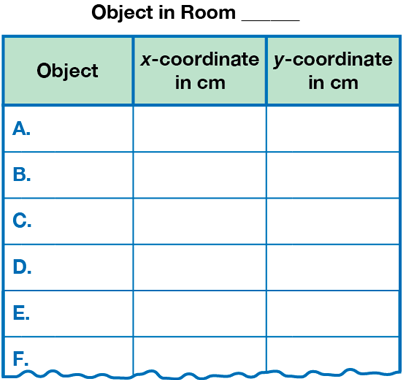Yellow
Green
Blue
Red
Magenta
Remove
Instead of using directions like left and right, mathematicians and scientists use positive and negative numbers. When Shannon translated her work into scientific language, she said that the x-coordinate of the teacher's desk was −200 centimeters and the y-coordinate was −150 centimeters. This is because mathematicians and scientists have agreed that on the x-axis, right is positive and left is negative. On the y-axis front (or forward) is positive and back is negative. By using positive and negative numbers we know the distance and the direction.
Use Coordinates to Make a Map
- You and your classmates will use Mr. Origin to help make a map of your classroom or your playground. First, place Mr. Origin somewhere in the area to be mapped. Your teacher may have placed Mr. Origin for you.
- The class or your teacher will choose some objects in the classroom to be mapped. Each object should be labeled with a letter of the alphabet.
- Work with your class to find the coordinates of the objects. Measure to the center of each object you are assigned. Record the distances on the Objects in Room _____ page from the Student Activity Book. Measure to the nearest centimeter.
- Make a coordinate grid to map the location of each object. Use Centimeter Grid Paper.

- Look at your data points. Decide where you need to draw and how to scale the coordinate axes so that all the points will fit.
- Label the x-axis and y-axis.
- Plot and label a point on the map for each object.








 Wherefore Art Thou, Romeo
Wherefore Art Thou, Romeo


